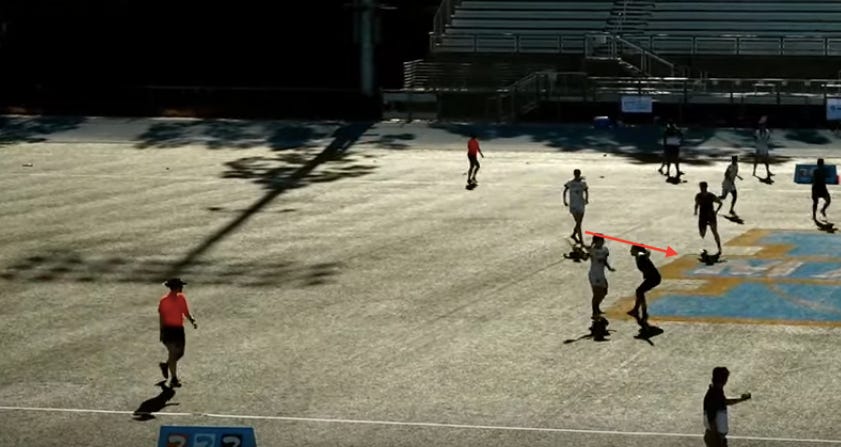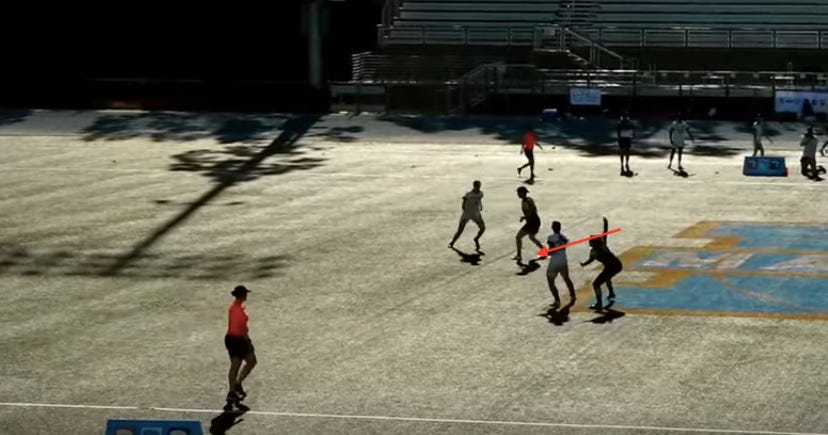This post is part of a (planned) series on cutting techniques.
A segment in this video on moving without the ball (in basketball) caught my eye. It's something I do often playing ultimate, which I think is underappreciated. At the 4:39 mark, he shows an example where Larry Bird "walks his man into the screen...", to quote the voiceover.
Now...let's ignore that screens are legal in basketball but not in frisbee. We can also ignore that the next line of the voiceover is "...and then pushes off to create separation". This technique will work even without screens or illegal push-offs.
Here's what's important: a good cut often starts long before any of the running fast even starts, by the way you walk around the field to manipulate your defender into an advantageous position. In the linked example, the defender wants to stay between Larry Bird and the basket. So when Bird walks towards the basket, the defender moves too, staying between him and the basket. This creates an open space behind Bird, and he can accelerate away from the defender and into that space.
Doing a little more research, I found another example from a video about Steph Curry. It's an even better example since all of the action is caught on camera. Check out this clip of Curry walking his defender into a new position before cutting to catch a pass:
I think there are a few reasons this trick works pretty well:
1. The defender wants to maintain a relative positioning.
In the example above, the defender wanted to stay between Larry Bird and the basket. So Bird walked towards the basket and the defender moves with him, leaving behind an open space. Many of the situations where this trick works are like that example: you want to walk your defender away from an open space that you're trying to create, and then cut back into that space.
Let's bring it back to ultimate frisbee. Although this can work downfield as well, the most obvious examples are seen in dump cuts: Here is an example I found in a frisbee game, although the person making the cut doesn't actually end up getting the disc.
Just to emphasize how important this technique is, let me tell you how I found this example: I typed "Raleigh Ring of Fire" into YouTube, clicked on the second full-game video that showed up in the list (I clicked on this one over the first result b/c it looked like a better/more important game), and then clicked on a random spot in the video. I found this example in the next point played.
Watch the clip above. Dylan Freechild walks forward directly into his defender, and then cuts backwards to try to receive a dump pass. Freechild's defender is trying to maintain a "relative positioning", too: he's trying to stay on the downfield side so Freechild can't easily get open for an upline cut. So Freechild walks directly into the defender, creating more open space behind him, and then cuts into that open space.
2. You put yourself between the defender and the open spot.
Another benefit of this technique is you use your body position to block the defender from having access to the space where you want to receive the disc. Here's a screenshot I took of the moment before Freechild starts walking into his defender:
I've added arrows to show the direction Freechild and his defender would each run if they want to attack/defend the dump space (the head of the arrows are on the point where Freechild actually cuts to). What's important here is the open space between Freechild's defender and the place where he wants to catch the dump pass. Freechild's defender can accelerate at full speed towards that spot to attempt to get the D.
Now look at the situation after Freechild walks into his defender, just as he starts his cut:
What's important here is that Freechild put himself into the space between his defender and where his defender wants to run to. Instead of being able to accelerate in a straight line, the defender has to either (a) run a longer path around Freechild or (b) stay on the downfield side of Freechild instead of accelerating at full speed.
3. Lots of defenders are reactive instead of thoughtful
Many cutting tips will work better against mediocre defenders than they do against great defenders.
Many defenders react to the cutter that they're guarding, instead of thinking for themselves about what they need to do in that moment to help the team. So, a defender sees me walk three steps to the left, and they walk three steps to the left as well, regardless of whether walking three steps to the left has actually helped their team achieve its goal of forcing a turnover. Yes, sometimes defenders will walk with you in order to achieve their goals (see #1), but sometimes you can move the defense by walking just because they're watching you and doing what you do, assuming that's a good idea.
As a sub-note on the theme of doing things on instinct, I think one reason a defender will back up when you start walking right at them is that it takes practice to overcome the human instinct of not letting someone walk right into us. A stationary defender obviously has a right to the space they're standing, but they'll still be subject to their own instinct to move out of the way when they see someone walking right at them. As cutters, we can often take advantage of this little instinct. This is a little bit of a Jedi Mind Trick.
A counterexample:
Here's an example of a case where walking into the defender could've made the pass much easier. Ironically, the clip above that I've called a positive example ends with the cutter not getting the disc, and the clip here ends with the cutter getting the disc. But on this blog, we're about process over outcomes, as they say.
Watch the above clip from the WUL's 2022 semifinal game between the Arizona Sidewinders and Seattle Tempest. Two seconds into the clip, the dump handler has an opportunity to walk forwards into the defender about 4 yards in front of them, creating the open space behind them that the defense will be boxed out from. At that moment the situation looks like this:
Instead, they stay where they are, and four seconds into the clip the defender has walked into them, making their job much harder. It looks like this:
Finally, the dump handler makes a fake and cuts toward the dump space, however, they fake by going around the defender, meaning that the defender has free space to accelerate into the passing lane. The defender's not quite quick enough to force the turnover, but they come pretty close. Here's the screenshot where you can see the dump handler making a fake behind the defender:
Although they catch the reset pass, I think their job clearly would've been easier if they got up into their defender's body before the cut.
Obviously there's a lot going on here that I don't know about, and it's possible what actually happened in this play is different from how I've interpreted it—for example, if the dump handler had expected the thrower to look for a quick dump pass a few seconds earlier, while the dump defender was still sagging off, the dump handler would've been in a perfect position, wide open. So there's a bit of instinct required here—if you think you're about to receive an open dump pass, you may want to stand where you are. But if you see the person with the disc continuing to look upfield, you'll need to fight for better positioning to set up your cut before the defense takes that position away from you.
Summary
Walking (especially walking into the defender) does two things: you've created an open space to cut into, and you've boxed your defender out from getting to that space.
I think this is a technique that many skilled cutters are already using (see the Dylan Freechild clip), but it's under talked-about, possibly because its so instinctual that they don't have an explicit concept of what they're doing, or, possibly because we too often think of cutting simply as "change of direction when running hard", and don't appreciate all that goes into finding the time and the place to make those hard runs.
There's also an odd paradox here: our ultimate goal is to get away from our defender, but this whole post is about the benefits of getting closer to the defender. Perhaps that's another reason this technique isn't fully appreciated—we don't get past the level of "my goal is to be far away from my defender" to understand the (sometimes) benefits of being near the defender.
PS — Other resources:
One of my goals in blogging is to try to write things that haven't been written before, or at least write them better in some way (more thorough, more clear, etc.) than they've been written before. To do that, I need to know what has been said before, so I research a topic to see what's out there, even if I already know what *I* want to say. Here's what I've found so far on walking before cutting:
Ultimate Rob also has a great article on cutting, which covers in just a few words some of what I've written here:
For the most part the physical attributes of cutters and defenders will be similarly matched, so the offensive player needs to use their wits to get free...
...the first thing the cutter should do is move the defender. They should back them up or drag them to a space away from the target of the cut. If a cutter is at the front of the stack the defender is almost certain to setup between them and the thrower, probably shading to the open side. By walking (or jogging, whatever) forwards, the defender is forced to back up to maintain their position between the cutter and the disc.
And much like my connection to basketball, in another article on cutting he uses clips of football players to highlight cutting techniques.
My article here tries to be better in some way by both fleshing out the theory and providing video examples.
2022-06-25 — Edited to add:
Although it isn't technically walking, I found this clip of friend of the blog Travis Dunn making a scoring cut. This cut highlights the main points of this article, and gives you a video example of this technique being used in the downfield space. You may need to replace walking with jogging in this case, but the main themes of this article are still present:
1. The most important part of the "cut" happens before he ever starts the "running fast" part.
2. Instead of "making a juke" or trying to get the defender to "change their hips", he just boxes the defender out from the open space (before the pass even happens) by going right into their body, and then exploding back towards the open space.
[Update (2025-05-22)]:
Here’s a great clip of walking before cutting from Elise Freedman’s 2025 Callahan video (at 0:31-0:35):
The defender wants to stay to the left of her (from the camera’s perspective). So she just walks the defender further and further left until the defender’s pretty much out of the play and all she has to do is cut towards the disc.
Another small thing I like about this clip is how she’s started her motion before the thrower has picked the disc up off the ground. Time the cut to when the thrower will be ready to throw—even if that means you have to start your cut when the disc is still on the turf.




